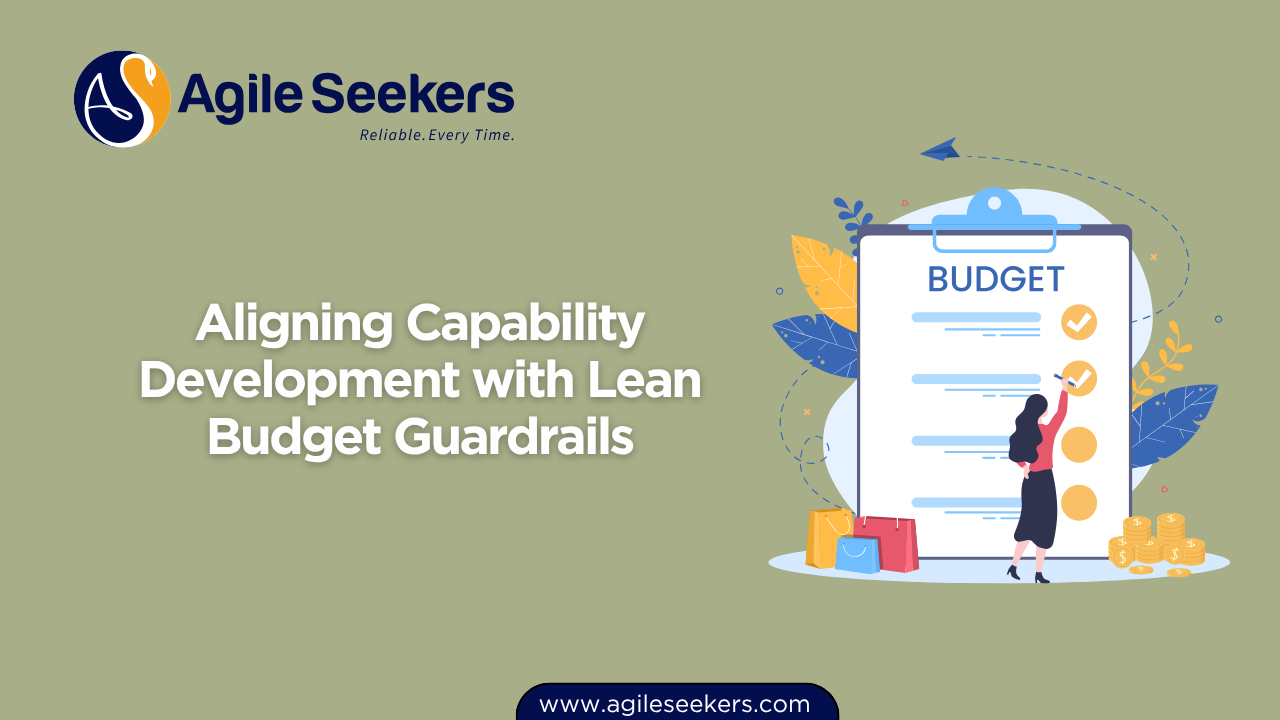Aligning Capability Development with Lean Budget Guardrails

In a SAFe (Scaled Agile Framework) environment, capability development doesn’t operate in a vacuum. It must be strategically aligned with the enterprise’s financial governance mechanisms—namely, Lean Budget Guardrails. These guardrails ensure that investments in capabilities deliver measurable value, remain within boundaries, and support strategic themes. Without this alignment, organizations risk misallocating funds, over-investing in non-priority initiatives, or creating solutions that deliver little actual value.
This post explores how Lean Budget Guardrails provide the financial structure to guide capability development decisions at both portfolio and value stream levels.
Understanding Lean Budget Guardrails in SAFe
Lean Budget Guardrails are guidelines established to provide oversight and governance in decentralized funding environments. They are essential in enabling agility while maintaining financial responsibility. The four primary guardrails are:
-
Guide investments by horizon
-
Ensure investments align with strategic themes
-
Provide capacity allocation guidance
-
Approve significant initiatives
These guardrails are not constraints; they are directional signposts that help Agile Release Trains (ARTs) and Solution Trains make informed decisions on funding and capability development.
What Are Capabilities in SAFe?
A capability in SAFe is a higher-level solution behavior that typically spans multiple ARTs and is sized to fit within a Program Increment (PI). Capabilities are decomposed into features that ARTs can deliver incrementally.
To learn more about capability-level planning and roles involved in SAFe product development, explore the SAFe Product Owner/Manager certification offered by AgileSeekers.
Why Align Capability Development with Lean Budget Guardrails?
Capability development often involves cross-cutting investments across platforms, architecture, and feature teams. Without alignment with guardrails, teams may:
-
Invest in capabilities that don’t support strategic priorities
-
Struggle with resource conflicts across ARTs
-
Deliver capabilities that can’t be released incrementally
By aligning with Lean Budget Guardrails, capability development becomes:
-
Strategic – driven by clear value propositions
-
Disciplined – following allocation and approval practices
-
Responsive – able to adjust based on empirical economic insights
Aligning with Guardrail #1: Guide Investments by Horizon
Horizon-based investment thinking encourages a balanced portfolio—investing in:
-
Horizon 1: Core existing capabilities
-
Horizon 2: Emerging differentiators
-
Horizon 3: Exploratory innovations
Each capability should be categorized by horizon to ensure balanced risk and growth. Portfolio teams should assess where capabilities fall, helping them allocate budgets rationally.
For example, a retail enterprise modernizing its checkout engine might categorize this as a Horizon 1 investment. But a blockchain-based supply chain capability might fall into Horizon 3.
McKinsey’s 3-Horizon framework provides a useful reference model for this classification.
Aligning with Guardrail #2: Ensure Investments Reflect Strategic Themes
Strategic themes represent enterprise priorities. Every capability must be traceable back to a strategic theme. Portfolio Kanban systems should filter or reject capabilities that don’t have this alignment.
Use weighted scoring models or WSJF (Weighted Shortest Job First) to prioritize capabilities that offer the best strategic alignment.
You can deepen your understanding of WSJF and prioritization by exploring the SAFe POPM Certification, which covers prioritization strategies and economic decision-making.
Aligning with Guardrail #3: Provide Capacity Allocation Guidance
Capabilities consume capacity across multiple ARTs. Lean Budgets allocate funding not to projects, but to value streams, which need clear capacity allocation to:
-
Balance features vs. enablers
-
Maintain architectural runway
-
Reserve room for compliance or security initiatives
A capability like "Real-Time Analytics Engine" might be broken down into:
-
50% capacity for feature development
-
30% for technical enablers
-
20% for architectural runway
Portfolio leadership must collaborate with RTEs (Release Train Engineers) and System Architects to set and monitor these allocations. Misalignment results in either delivery delays or technical debt.
Aligning with Guardrail #4: Approve Significant Initiatives
Capabilities that exceed a certain threshold of investment or risk must go through formal approval workflows—often through Epic Owners and Lean Portfolio Management (LPM).
Key checkpoints include:
-
Lean Business Case development
-
Economic evaluation (cost of delay, NPV)
-
Milestone reviews
Before significant capability work begins, LPM should validate the business need, technical feasibility, and alignment with the strategic roadmap.
SAFe Lean Portfolio Management guidance provides more detail on approval thresholds and governance workflows.
Capability Roadmaps and Funding Cadence
Aligning capability roadmaps with funding cadences—like Program Increments (PIs)—ensures synchronized planning. Regular PI planning sessions should include:
-
Capability readiness assessments
-
Budget burn tracking
-
Dependency and risk evaluation
This alignment prevents ad hoc prioritization and supports agile forecasting.
Metrics to Monitor Alignment
To verify capability development is adhering to Lean Budget Guardrails, track the following:
-
% of capabilities mapped to strategic themes
-
% budget allocation by horizon (H1, H2, H3)
-
Cost of delay per capability
-
Time to value vs. budgeted forecast
-
% of unplanned work in capability execution
These metrics help the PMO and LPM ensure transparency, reduce waste, and support enterprise agility.
Final Thoughts
Aligning capability development with Lean Budget Guardrails isn't just about governance—it's a disciplined way to ensure every dollar fuels strategic outcomes. It blends Agile adaptability with financial accountability, ensuring teams build the right things, at the right time, for the right reasons.
To develop the mindset and tools required for this alignment, enrolling in SAFe Product Owner Certification courses equips professionals with hands-on knowledge of economic prioritization, Lean funding models, and capability-centric thinking.
Also read - Integrating DevSecOps Metrics into ART-level Reviews
Also see - Leveraging Solution Intent for Technical Governance in Large Solutions




















